
COVID-19 has left no corner of the United States untouched, according to the latest Rural America at a Glance. As of Dec. 30, there have been more than 82 million global coronavirus cases, including more than 19.6 million in the United States. More than 340,000 people in the United States have died from COVID-19, according to the Johns Hopkins Coronavirus Resource Center.
The USDA Economic Research Service report, which ended data collection on Nov. 1, found that beginning in late September, the highest incidence rate for new infections was in rural counties, while the lowest was in major metropolitan areas. This marked a reversal of the situation from earlier in 2020, when the virus spread quickly in major metro areas.
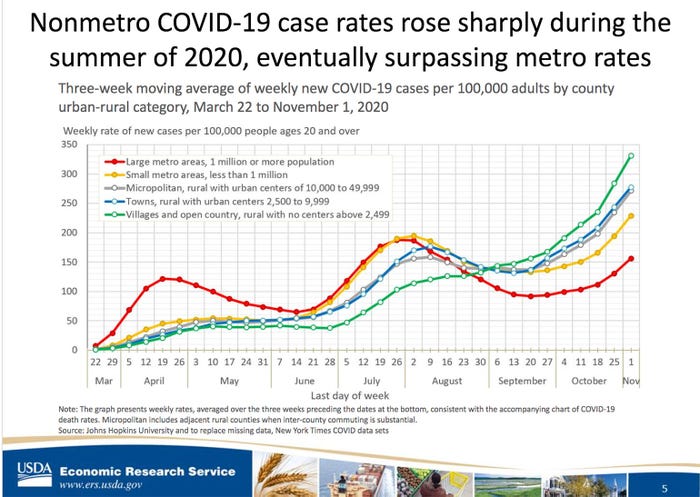
Likewise, the moving average of nonmetro death rates surpassed metro rates starting in late August.
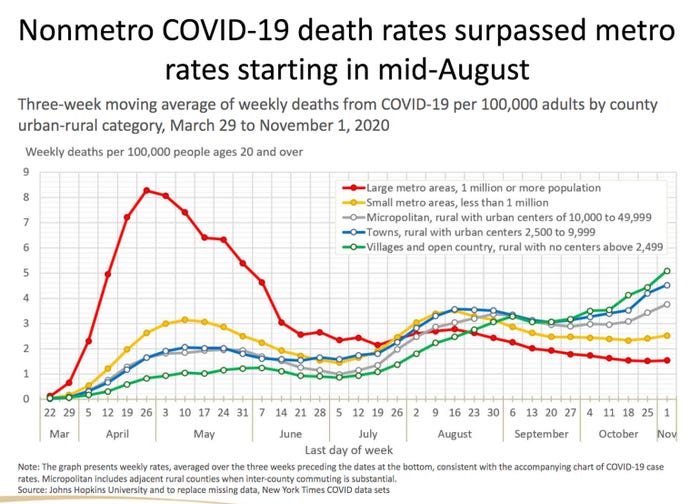
The fall-winter flare-up, which was ongoing as of the report's writing and release, had an infection pattern that was exactly the opposite of the initial flare-up of COVID-19, according to the report's authors.
"Rural rates of COVID-19 mortality were never previously higher than they were in late October, and the rise in cases during this period suggests that rural mortality is likely to continue increasing," the authors said. "In contrast, rates in large metro areas were the lowest since the beginning of the pandemic, although their recent rise in case rates suggests that this situation may change."
Rural areas appear to be more vulnerable to COVID-19 than urban areas, said Elizabeth A. Dobis, an ERS research economist who worked on the report. She cited four factors:
Underlying health problems,
A higher percentage of residents older than age 75,
A lack of health insurance, and
Distance to hospitals with intensive care units.
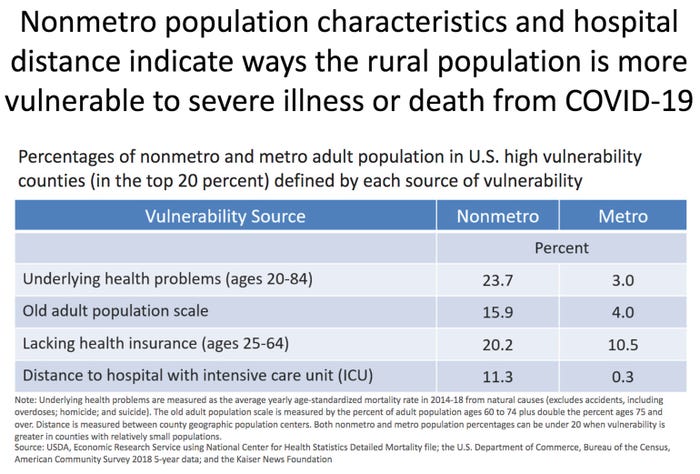
In 2016-17, 116 counties, or 4% of U.S. counties, did not have a facility to provide basic medical care to its residents. Of those 116 counties, 83% are nonmetro. In addition, residents in 22% of counties must drive outside their county of residence to receive hospital care and only 60% of counties with hospitals also have an ICU. The majority of counties without a hospital are nonmetro, at 67%.
As some COVID-19 patients quickly develop serious symptoms, the distance from hospital care becomes an issue.
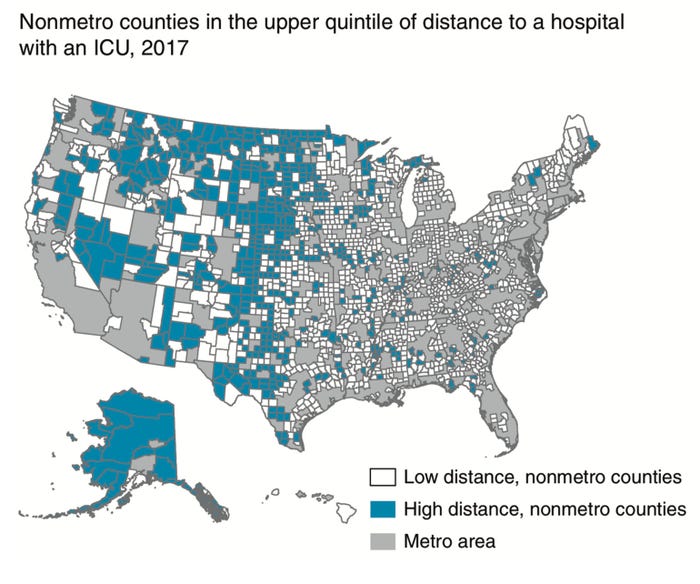
Rural average weekly COVID-19 mortality rates in the last three weeks of October were much lower than those in major metro areas during the first COVID-19 flare-up in March, but health care workers have learned how to treat COVID-19 cases in the ensuing months, Dobis said.
COVID-19 and meatpacking
More than half a million people work in the U.S. meatpacking industry with meatpacking accounting for more than 20% of all-county employment in 49 non-metro counties and seven metro counties.
These counties make up 2.5% of all rural counties and represent 19% of all meatpacking employment in the United States. The employment dependence makes meatpacking a unique manufacturing industry in the United States. Beginning in mid-April, the confirmed number of COVID-19 cases in meatpacking-dependent counties began to outpace those seen in all other counties across the country.
The two-week moving average number of new daily cases rose in meatpacking-dependent counties through the remainder of April, reaching a peak of nearly 50 cases per 100,000 population by the end of the month, more than 10 times the prevalence seen in other rural counties. The cases in meatpacking dependent counties started to decline in May, but remained higher than other rural counties, failing to less than seven times. The number of average daily cases per 100,000 population by the end of May. Partial plant closures and increased social distancing protocols were implemented at meatpacking plants starting in late May. In June, there was a sharp reducing in cases in meatpacking-dependent counties.
Both meatpacking-dependent and other rural counties saw modest declines in the two-week moving average number of new daily cases per 100,000 through mid-September. Since Sept. 15, all rural counties have seen a surge in average new cases per 100,000.
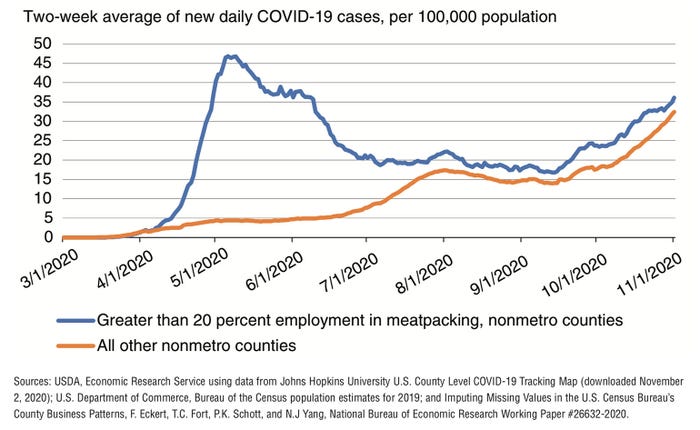
Rural unemployment
Nonmetro unemployment rates have been lower during the pandemic. In mid-August, nonmetro unemployment rates were highest in mining-dependent counties and lowest in farming counties.
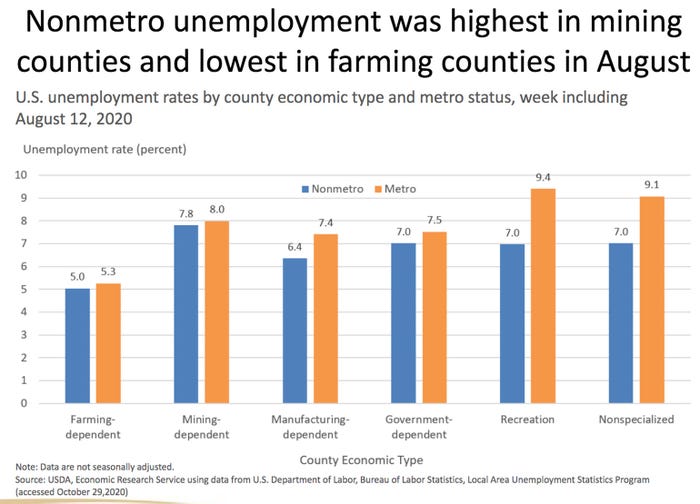
Read more about:
Covid 19About the Author(s)
You May Also Like




